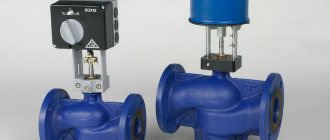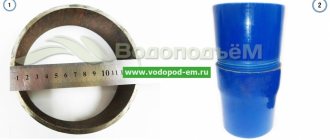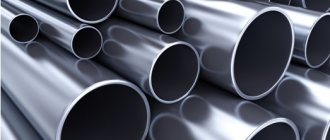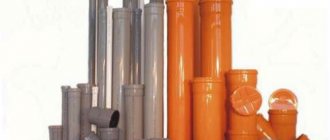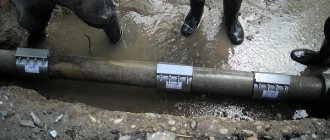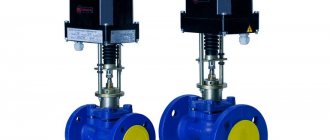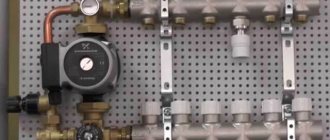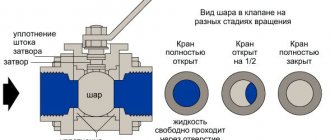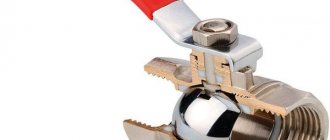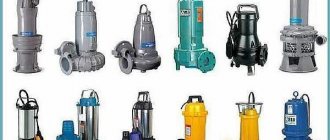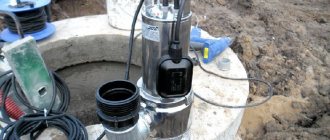A vortex pump is a device whose task is to pump water from wells, reservoirs and storage tanks. Equipment of this type is used in conditions where it is necessary to create high pressure of liquid with relatively small volumes. At the same time, the composition of the pumped liquid should not contain chemical impurities.
Vortex pump - device and principle of operation
The high-pressure vortex pump has a fairly simple design.
The main part of its device is an impeller equipped with blades. It is located in a durable housing and is fixed on the shaft. There is a gap between the body and the wheel, no more than 0.2 mm wide. The main difference between these pumps and axial units is the method of supplying fluid inside the casing. In vortex devices, liquid is supplied along the line of contact with the impeller. This design of the vortex pump makes it easier to operate and repair.
The operating principle of the device is to rotate the wheel along with the liquid. The sucked water is affected by the centrifugal force of rotation and the suction force that is generated in the grooves. Thanks to centrifugal force, the liquid is directed towards the periphery of the blades. As a result, a vacuum is formed in the grooves, due to which suction force appears. When it suppresses the centrifugal force, the water begins to move towards the wheel.
This procedure is repeated until the impact forces become equal. As a result, a vortex appears on each of the blades, which increases the pressure. Despite the rather complex principle of operation, the design of a vortex pump is extremely simple.
Design Features
The main element of any vortex pump, as mentioned above, is an impeller (impeller), equipped with blades, which can be located in a radial or inclined position relative to the axis of such a wheel. The rotation of the impeller occurs in the inner part of the cylindrical chamber, the gaps between the walls of which and the end parts of the blades are minimized. The liquid medium is first sucked through the inlet, then moved by the action of the blades in the inner chamber of the pumping device and pushed out through the outlet.
Structurally, the impeller of a vortex pump is a large steel disk, around the circumference of which recesses are made using milling to form the blades. The inlet and outlet pipes of the vortex pump are located in the upper part of its body.
Impeller (vane impeller) of a vortex pump
In the inner part of the vortex pumping devices there is a drainage channel, which is concentric with the shaft axis and directed from the receiving pipe to the outlet. The separation of the suction and pressure cavities of the working chamber is ensured by a special jumper, which is pressed against the impeller with the minimum existing gap (two tenths of a millimeter) and simultaneously overlaps at least two blades.
If we compare vortex pumps with devices of the conventional centrifugal type, then with similar sizes and equal impeller rotation speeds, the former are capable of creating a significantly higher pressure of the pumped medium (seven times more). Due to the peculiarities of their design, vortex pumps can not only operate in a self-priming mode, but also pump gas-liquid media.
Vortex pump device
The impeller of a vortex-type pump, rotating inside its housing, is located eccentrically in it. This creates the smallest gap between the end part of the blades and the inner walls of the chamber. The most significant difference between centrifugal and vortex pumps is that in the latter, the liquid entering the working chamber moves tangentially to the circumference of the impeller. The movement of liquid along a special groove running along the entire circumference of the working chamber is ensured by centrifugal forces created when the liquid medium rotates together with the impeller. The channel through which the liquid inside the vortex pumping device moves from the receiving pipe to the outlet pipe is divided by a special sealing lip. The latter is necessary in order to prevent the pumped liquid from entering the suction chamber from the pressure zone.
Advantages and disadvantages of vortex equipment
Vortex water pumps have several advantages. These include:
- Lower cost compared to other types of equipment;
- Simple design;
- Ability to independently absorb water;
- Possibility of use in liquid-gas mixtures.
Units of this type also have a number of certain disadvantages. Firstly, they have low efficiency - on average it does not exceed 45%. This indicator does not allow vortex pumps to operate at consistently high power. Secondly, the pumps cannot cope with pumping high-viscosity liquids.
Operating rules
The described unit is installed on a hard surface strictly horizontally and, if possible, closer to the source of water intake. In case of vibrations, it is also advisable to secure the structure with a metal frame or bolted frames. The pump is connected to the network through the RCD fuse block. Grounding can be provided with a steel wire about 6 mm thick. In this case, one end of it is attached to the body, and the other to a ground electrode in the form of a metal pipe from a well or any structure leading into the ground.
Next, you can begin direct operation of the vortex pump, checking its tightness and the correctness of the connections made. First, the suction pipe and pump part are filled with liquid. To do this, you can use a funnel and a filler outlet in the structure. When the pumping part is completely filled, you can put the equipment into operation.
Classification of units by method of action
Depending on the mode of action, vortex pumps can be of the following types:
- Reciprocating - in such units, fluid circulation is carried out by moving a piston located in the cylinder. On sale you can find reciprocating vortex pumps, both with a piston and with a membrane;
- Rotary - in these devices a piston displaces water. Based on the type of working body, such pumps are divided into roller, screw, vane and gear pumps;
- Dynamic - in these pumps, the movement of liquid is carried out as a result of the transfer of kinetic energy to it.
Each of the listed types of units has found application in specific areas. They differ from each other in design and dimensions.
Subtleties of choice
On the market you can find vortex pumps of various modifications, differing in both technical parameters and cost - how to choose the right model among them? To do this, focus on the following factors:
Surface Vortex Pump
- Suction depth. Select specifically for the depth of your well, but with a small reserve, about 10%, so that the device does not have to work at its limit.
- Pressure To calculate, add up the suction depth and the height of the pipeline that will supply water directly to the taps.
- Performance. It is calculated taking into account two factors: the number of consumers and the amount of equipment consuming water. As practice shows, for water supply to a house with a basic set of equipment (bathtub, toilet, washbasin, washing machine, kitchen sink, outdoor watering tap), in which a family of 2-3 people lives, a pump with an average productivity of about 40 l/min is sufficient .
- Materials. Since the device will be in direct contact with water during its operation, you should pay special attention to the materials of the housing and impeller - they should neither oxidize nor stain the water. The best option: body – brass or cast iron; wheel - bronze or brass.
Advice. If power surges frequently occur in your area, buy a vortex pump with a voltage stabilizer.
Separation of pumps according to the type of arteries and wheels
Depending on the location of the waterway, the following types of vortex pumps can be found on sale:
- Units with open artery:
- Pumps with a closed water artery.
According to the types of impellers, pumps are divided into:
- Open wheel equipment;
- Devices with a closed wheel.
Closed-type pumps are equipped with short blades. Liquid suction is carried out through a special pipe. Such units have a low cavitation rate. Due to the joining of the longitudinal vortex and the liquid substance, the rate of movement of the water at the inlet slows down slightly. In order to increase the cavitation properties, a centrifugal stage is connected in front of the vortex wheel. Such equipment is called centrifugal-vortex. These units have a slightly higher efficiency than vortex pumps, about 48%. Devices of this kind are widely used for water supply systems and boiler power supply.
Units with an open wheel differ from devices of the previous type by the longer blades. Due to this, their cavitation rates are an order of magnitude higher, which allows them to be used for pumping wastewater in industry and utilities.
Nowadays, many manufacturers combine the properties and advantages of several types of equipment in pumps. Thanks to this, on the modern market you can find vacuum, air and thermal vortex pumps. The main difference between these devices lies in the technical characteristics and areas of application. Units of the first type are successfully used in the chemical industry for working with gaseous substances. Thermal devices have found application in providing liquid to various steam power plants. Air vortex pumps are used to maintain the operation of deep industrial water wells.
Main varieties
Vortex pumps according to their design are divided into two categories:
- open-vortex;
- closed-vortex.
Pumps of the first type are distinguished by the following design features.
- The blades with which the impeller is equipped have an elongated shape.
- The impeller, when compared with the lumen of the working channel, has a reduced diameter.
- The annular channel is connected to the pressure pipe.
Diagram of a vortex pump with an open channel
Electric pumps of the closed-vortex type also have certain design features.
- The blades of pumps of this type, when compared with similar elements of open-vortex devices, are shorter and are located on the surface of the impeller at different angles.
- The cross section of the inner chamber is equal to the diameter of the impeller.
- The annular channel of closed-vortex pumps is connected to both the receiving pipe and the output pipe.
Diagram of a vortex pump with a closed channel
Naturally, the differences affect not only the design of pumping equipment of these types, but also the operating principle of such devices. Open-vortex type pumps operate as follows.
- The pumped liquid enters the internal working chamber through the receiving pipe.
- Captured by the rotating impeller, the pumped medium enters the annular channel.
- The vortex flow of the pumped liquid, moving along the annular channel, contributes to the formation of a pressure flow, which is directed to the outlet pipe.
Since the diameter of the impeller in closed-vortex pumps, as mentioned above, is equal to the cross-section of the working chamber, the liquid from the inlet pipe immediately enters the annular channel, where a pressure flow is created.
Open Type Multistage Vortex Pump
Vortex type pumps are classified according to their location relative to the pumped medium. So, depending on this parameter, they distinguish:
- submersible-type devices, which, as their name implies, during operation are located in the thickness of the pumped medium (such pumps are used for both domestic and industrial purposes, pumping with their help clean liquids of not too high viscosity);
- surface-type pumps, which are located in close proximity to a reservoir with a liquid medium or a well, reliably protecting their housing from liquid ingress (equipment of this type is equipped with irrigation systems and water supply systems for domestic purposes).
Surface vortex pump for domestic use, designed to supply clean water from wells or wells
In addition to vortex pumps of classical design, modern industry produces combined devices.
- Free-vortex pumps have a design that allows them to pump highly contaminated liquid media. These devices are used as drainage and sewage pumps, as well as for equipping treatment facilities and in the mining industry (without the help of such equipment, drilling wells from which it is necessary to pump out liquid media is not possible).
- Centrifugal-vortex pumps are capable of working with liquid media whose temperature reaches 105°. A design feature of such pumps is that they are equipped with two impellers at once: centrifugal and vortex. Due to this design feature, this equipment is characterized by significantly higher efficiency (compared to classic vortex devices).
- Vortex vacuum pumps can be used as a blower or for pumping out air - creating a shallow vacuum. Such pumps are easy to use and do not require complex maintenance. They are widely used as a thermal apparatus, which ensures the supply and distribution of the required amount of warm or cold air. In particular, such equipment is successfully used for drying glass containers; it is used to aerate artificial and natural reservoirs.
Areas of application of vortex pumps
It is quite difficult to imagine modern industry without pumping equipment. Vortex pumps were no exception. Today they are used in the following industries:
- To maintain the operation of boiler stations;
- For pumping liquids containing gaseous components;
- To supply water to rural water stations;
- For the operation of automobile service stations;
- As elements of compressor units;
- For the purpose of pumping alkalis and acids.
Smooth operation in all these industries requires pumps to withstand mechanical damage, aggressive chemicals and wear.
Submersible and surface models
The difference between these designs lies in their name. Thus, submersible models are operated in a liquid environment and are capable of moving liquids with low viscosity. Surface - pump only filtered water for watering the garden or home water supply.
- Combined options.
Free vortex structures are capable of pumping contaminated liquid in drainage systems and sewers.
Centrifugal vortex structures have greater efficiency compared to classical versions and can pump liquids heated to a temperature of + 105 °C. A vortex and centrifugal wheel are installed here at the same time.
Vortex-type vacuum pumps are designed to distribute air of different temperatures and can create a slight vacuum.
Vortex or centrifugal pump - which is better?
In order to understand which is better - a centrifugal or vortex pump, you should decide on several factors - areas of application and characteristics of the units. Centrifugal pumps can be used to pump clean water or water containing small impurities from ponds no more than 9 meters deep. During operation, such devices create a small pressure, consume a significant amount of electricity and have quite large dimensions.
The main difference between a vortex pump and a centrifugal pump is that units of the first type create greater pressure while having the same power. They are smaller in size and consume much less electricity. In addition, vortex pumps can pump liquids containing gases.
For comparison, it is also important to note the disadvantages of vortex pumps, which centrifugal devices do not have. The main one is the instability of vortex units to frequent mechanical damage. In contrast, centrifugal pumps are made of cast iron, which can withstand shock easily.
When comparing units of both types, it is quite difficult to determine the best one.
We can only note that if the buyer does not need high pressure and wants to pump out dirty water, then you can purchase a durable centrifugal pump, which, moreover, will operate much quieter. If you need to achieve maximum pressure, then it is better to purchase a vortex unit - it produces more noise, but costs an order of magnitude cheaper. We should also not forget that manufacturers constantly combine the properties of different types of pumps. Today it is very easy to purchase a centrifugal vortex pump that will have all the properties and advantages of the units we are comparing.
Installation
Before installing the pump, a well inspection will be required, namely, checking its geometric parameters:
- verticality;
- straightforwardness;
- section stability.
To do this, take a piece of pipe whose dimensions are literally 5-6mm larger than the diameter and length of the purchased pump. The template is gradually immersed into the well, revealing hidden deep defects. Detected curvatures and various narrowings are corrected.
Before installation in a well, it is recommended to check pumps for jamming, play, etc.
After the preparatory activities, the main stage of work begins:
- tie the fastening cable to the eyes on the pump body;
- connect the pressure pipeline to the upper branch pipe;
- fix the network cable with a slight sag to the installed pipes. The clamps are attached at a distance of no more than two meters;
- lower the prepared structure into the well;
- connect the power supply.
During installation, please note that the pumps should not reach the bottom. The minimum distance is 100mm. In this case, bottom sand or silt will not be sucked into the water intake grid. At the same time, the water in the well must cover the pump, otherwise it will quickly fail.
Self-priming water pumps: types, operating principles, operating recommendations
Self-priming pumps are a special type of surface equipment designed to increase the working life. Their moving parts are always cool, seals are not damaged, and the motor operates flawlessly. However, due to the large assortment, it can be difficult to settle on a suitable model. Do you agree?
Everything you need to know about self-priming water pumps can be found on our website. We have described in detail the principle of the design and operation of units of this type, and the differences in design are given. The information we provide will help you make an informed purchase.
We described in detail the different options for self-priming pumps and provided recommendations for operation. Useful photo and video applications will help you deepen your knowledge.
There are self-priming and normally priming devices. The difference lies in the design that regulates the refilling process if air gets into the system.
Principle of operation
The operating principle of vortex pumping equipment, as in centrifugal-type devices, is based on the use of centrifugal force that occurs when the impeller rotates. However, unlike centrifugal analogues, vortex pumps have their own operating features, which are as follows:
- As the impeller of pumping equipment rotates, a small volume of water from the suction line enters the grooves on the impeller.
- As a result, it moves from the periphery to the center of the unit, which is not similar to the operation of a centrifugal pump.
- After this, this volume of water, under the influence of centrifugal force, begins to move along the blades from the central part to the periphery.
- As a result, the water gets accelerated and is thrown out into the outlet.
- Here the speed energy of water turns into pressure energy.
- Under the influence of pressure and the suction action of the blades, a new volume of liquid again enters the blades and the cycle repeats.
Important: during one revolution of the impeller, the cycle of pressure generation and the suction action of the blades is repeated many times, which contributes to an increase in energy and an increase in pressure.
Their operating principle is slightly different, since the first type of pumps have:
Types of self-priming pumping devices
By type, this equipment falls into two directions: vortex and centrifugal, where the latter are more popular. Also, certain modifications are equipped with built-in or remote ejectors, while other models do not have ejectors. Despite the high percentage of similarities of many self-priming devices, the process of their operation, as well as other features, often differ.
It is important to understand that such pumps must be turned on when a certain condition is met: the snail-shaped body must be completely filled with water. This is due to the impeller, which cannot create pressure in any other way. Although many people call this nuance a disadvantage, otherwise there are practically no disadvantages.
